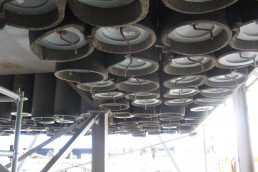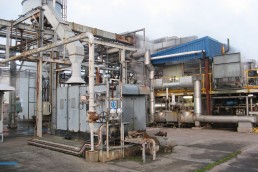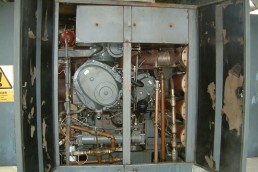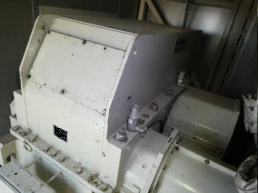Asset Life Assessment for Risk-Informed Decision Making
Background
As part of a global asset risk management initiative, Whitecastle Engineering Ltd (WEL) was commissioned to conduct an Asset Life Assessment (ALA) of critical rotating and production equipment across two major refineries. The goal was to quantify end-of-life risks, evaluate operational vulnerabilities, and provide an objective basis for CAPEX planning and insurance risk profiling.
Objectives
- Identify and document failure modes with high safety or business impact.
- Estimate residual life and reliability trends of critical equipment.
- Quantify asset-level risk and establish a mitigation hierarchy.
- Enable insurers and clients to align capital investment with risk reduction goals
Method
-
WEL’s systematic approach integrated engineering analysis with risk modelling, focusing on the following components:
-
Asset Condition Review
Interviews with site engineers, maintenance plan reviews, and analysis of historical data, design documentation, and spare part logistics. -
Degradation & Damage Mechanism Assessment
Identification of dominant wear, fatigue, corrosion, and obsolescence risks, based on both qualitative and quantitative asset evaluations. -
Risk Profiling
Each asset was assessed using a structured risk matrix, accounting for likelihood of failure (PoF) and consequence categories (CoF): safety, business interruption, environmental, and financial. -
Mitigation Strategy Development
Practical, cost-effective mitigation actions were proposed to reduce overall risk exposure (RRFs) . Post-mitigation residual risk was also recalculated. -
CAPEX Alignment & Investment Planning
A forward-looking 20-year investment plan was created, prioritizing actions based on risk reduction potential and asset criticality
-
Results & Recommendations
- The client’s existing maintenance strategies were generally effective, but select high-risk assets required targeted interventions.
- WEL developed a prioritized mitigation plan to optimize the cost-benefit ratio of investment against risk exposure.
- A CAPEX roadmap was produced to support long-term resilience and insurance alignment.
Value to Insurance and Risk Engineering
- Provides insurers with a technical foundation to refine risk scoring and underwriting criteria.
- Informs site-level loss prevention planning and inspection focus.
- Strengthens the client’s ability to demonstrate duty of care and due diligence for operational risk.
- Enhances visibility of latent risks associated with aging or obsolete machinery.
Related Posts
Specialty Insurance for Power, Renewables & Energy Transition
The energy transition is reshaping risk landscapes, and specialty insurance is evolving fast to keep pace.
Navigating the Energy Transition: Challenges & Solutions
Power Generation,Risk Assessment,Key Insights
The shift toward renewable energy and modern power systems brings both exciting opportunities and complex challenges.
Specialty Insurance for Power, Renewables & Energy Transition
The Latest in Specialty Insurance for Power, Renewables, and Energy Transition
The specialty insurance market for power, renewables, and energy transition is stepping up to tackle the new risks that come with decarbonization, tech advancements, and changing regulations. Insurers are rolling out custom solutions for everything from battery storage failures and hydrogen project risks to offshore wind construction delays and grid instability caused by intermittent renewables. Parametric insurance is becoming a big deal—it pays out fast when predefined triggers (like extreme weather or production drops) hit, which is a game-changer for renewable operators who depend on steady energy output. On the underwriting side, AI, IoT sensors, and advanced data analytics are helping insurers better predict and price risks, especially for large-scale solar, wind, and hybrid projects. But there are still gaps to fill—supply chain disruptions, cyber threats to smart grids, and performance risks for new tech require creative policy structures, like bundled multi-line covers and contingent business interruption extensions. For legal and operational teams, this means policies need to be tighter than ever, aligning with project finance terms and ESG regulations, which are getting stricter worldwide.
What’s Next? Challenges and Innovations in Energy Transition Coverage
As the energy transition speeds up, insurers are juggling fresh risks and opportunities. Traditional power players (think coal and gas) are dealing with phase-out liabilities—like stranded assets, environmental clean-up costs, and decommissioning risks—which need specialized legacy coverage. At the same time, renewables are pushing into riskier territory, from deep-water offshore wind farms to floating solar, calling for stronger engineering and marine liability policies. Then there’s the rise of carbon capture (CCUS) and green hydrogen, bringing entirely new risks, like subsurface leaks or electrolyzer breakdowns, forcing insurers to design first-of-their-kind covers with help from engineers and lawyers. Legal teams have their work cut out, making sure contracts cover regulatory hurdles and cross-border liabilities, especially for projects with multiple stakeholders. And with climate-related disruptions on the rise—wildfires, hurricanes, you name it—operators need broader catastrophe coverage. There’s also growing interest in “just transition” insurance, protecting workers and communities affected by the shift to clean energy. Bottom line? Insurers, legal experts, and operators need to stay in sync to keep policies ahead of the curve—balancing innovation with risk management as the sector transforms.
Related Posts
Specialty Insurance for Power, Renewables & Energy Transition
The energy transition is reshaping risk landscapes, and specialty insurance is evolving fast to keep pace.
Navigating the Energy Transition: Challenges & Solutions
Power Generation,Risk Assessment,Key Insights
The shift toward renewable energy and modern power systems brings both exciting opportunities and complex challenges.
Navigating the Energy Transition: Challenges & Solutions
Technological Challenges in Power, Renewables, and Energy Transition
The energy sector’s rapid transformation is driving both innovation and complexity, with operators and project managers facing pressing technological hurdles. Aging grid infrastructure must now accommodate variable renewable generation, demanding advanced energy storage and smart grid solutions to maintain stability. In renewables, scaling up turbine capacities, deploying floating offshore wind farms, and adopting high-efficiency solar panels bring engineering and logistical challenges—especially in extreme environments. Meanwhile, emerging technologies like green hydrogen and carbon capture (CCUS) introduce new uncertainties, from electrolyzer performance to long-term storage viability. Cybersecurity risks are also escalating as digital controls expand across power networks. And with the energy transition requiring seamless integration between legacy and clean energy systems, project teams must carefully balance innovation with operational reliability. Success hinges on selecting proven technologies, mitigating risks early, and ensuring compliance with ever-evolving regulations—all while keeping projects financeable and insurable.
Expertise and Proven Methods for Navigating the Energy Transition
Overcoming these challenges requires specialized expertise and methodical, field-tested approaches. Rigorous feasibility studies, risk assessments, and technology evaluations—backed by real-world data—help operators make informed decisions that align with financial and technical requirements. In renewables, data-driven site selection, performance modeling, and energy yield optimization ensure projects meet their targets, while grid modernization efforts benefit from strategic storage integration and cybersecurity best practices. For cutting-edge sectors like hydrogen and CCUS, structured pilot testing and scalable deployment frameworks reduce uncertainties and attract investment. Cross-disciplinary collaboration is equally critical, ensuring alignment between technical teams, regulators, insurers, and financiers. Additionally, streamlined permitting, environmental compliance, and ESG reporting processes keep projects on track amid tightening regulations. By leveraging proven methodologies and industry expertise, operators and project managers can mitigate risks, avoid costly delays, and drive the energy transition forward with confidence.
Related Posts
Specialty Insurance for Power, Renewables & Energy Transition
The energy transition is reshaping risk landscapes, and specialty insurance is evolving fast to keep pace.
Navigating the Energy Transition: Challenges & Solutions
Power Generation,Risk Assessment,Key Insights
The shift toward renewable energy and modern power systems brings both exciting opportunities and complex challenges.
Power Plant's Gearbox Failure Investigation and Root Cause Analysis
Background
Whitecastle Engineering was commissioned to investigate a catastrophic gearbox failure that led to an unplanned outage of a power generation unit in Peru. The failure occurred during a routine post-maintenance restart, resulting in elevated vibrations, excessive heat, and operational noise from the gearbox. The unit was promptly shut down under emergency procedures.
Objectives
Conduct a Root Cause Analysis (RCA) of the gearbox incident to:
- Diagnose the cause(s) of failure.
- Assess the historical maintenance regime.
- Provide strategic recommendations to prevent recurrence.
Key Findings
-
Inadequate Specialist Oversight: Unlike the generator, which had OEM’s dedicated support, the gearbox maintenance was handled by the Gas Turbine (GT) OEM, responsible for the maintenance of the unit through a Long Term Service Programme (LTP), using general service engineers without specific expertise in high-speed double helical gearboxes.
-
Ignored Warning Signs: Multiple inspections between 2017–2023 noted pinion erosion and unilateral wear patterns. The LTP provider’s personeel deemed the unit “serviceable” despite clear indicators of progressive deterioration.
-
Questionable Repairs: In 2021, the LTP provider conducted uncontrolled on-site grinding of pinion teeth—altering the tooth profile without the Gearbox OEM validation— reducing toothing contact area and increasing stresses and vibration, which accelerated the degradation of the gearbox integrity.
-
Sub-optimal Spare Strategy: The LTP provider failed to include a spare gear set in the critical spares list of the operator, despite long lead times (5–6 months) and the absence of inventory at their own facilities.
-
Failure Mechanism: The noticeable failure mechanism of the gear set was the circumferential slippage at the pinion and gear shafts’ interface. However, the root cause of the failure was the compounded effect of increased vibration due to loss of toothing contact area, misalignment of casing and/or bearings and off-design, dynamic loads caused by abnormal operating conditions (power grid instability).
Value Delivered
- Issued a clear, evidence-based technical report detailing causal chains and critical failings in the maintenance strategy.
- Provided a technical foundation for contractual and legal action.
- Recommended corrective measures including redesign of spares strategy, appointment of gearbox-specific specialists, and revised inspection protocols.
Lessons Learned
This case underscores the risk of generic maintenance practices applied to highly specialised components. Advanced turbomachinery requires domain-specific oversight—failure to act on early signs, combined with inadequate failure mitigation planning, can have significant operational and financial impacts.
Related Posts
Specialty Insurance for Power, Renewables & Energy Transition
The energy transition is reshaping risk landscapes, and specialty insurance is evolving fast to keep pace.
Navigating the Energy Transition: Challenges & Solutions
Power Generation,Risk Assessment,Key Insights
The shift toward renewable energy and modern power systems brings both exciting opportunities and complex challenges.
Gas Turbine Air Filtration Optimisation
Lack of compression a production issue
Recently Whitecastle Engineering Ltd (WEL) was commissioned to undertake a study regarding an issue with the performance of an Ethylene Plant built in the 1980’s. The gas turbine driving a process gas compression train had been underperforming for some time and the production of the plant was being affected accordingly. WEL were asked to identify the problems and were possible provided recommendations for a solution.
Air filtration Problem Identified.
WEL reviewed all available data and undertook a survey of the site in order to best ascertain the size and extent of the issues. Upon analysis of the acquired data it was determined that the main issue over and above that of poor maintenance was the need to upgrade old, ineffective and expensive air filtration elements.


Instrumentation deficiencies
WEL identified the lack of instrumentation that had not highlighted key issues such as punctures in the air ducts that were allowing unfiltered air into the turbine as well as the blow back filter cleaning function being inoperative and insufficient even if in full service.
Recommendations and Solutions
WEL put forward practical recommendations in the selection of alternative schemes emphasising on the pros and cons of each option. WEL recommended upgrading the filter element to a HEPA E10 filters which provided the best cost/benefit ratio from the various options analysed.
Related Posts
Power Plant’s Gearbox Failure Investigation and Root Cause Analysis
StickyGas Turbines,Root Cause Analysis,Risk Assessment,Case Study
Gearbox failure investigation supports operators and insurance teams to clarify root causes and define risk mitigation strategies
Gas Turbine Air Filtration Optimisation
Gas Turbines,Troubleshooting Analysis,Maintenance and Spare Management,Production Optimisation,Case Study
Maintenance strategy review of a gas turbine air filtration system in an Ethylene plant in the UK
Air Compressor Reliability Analysis
Compression issues increase costs and decrease production
Whitecastle Engineering Ltd (WEL) were recently contracted to undertake a reliability review of air compression issues on an Ethylene Plant in the UK. Continuing problems with the onsite compressors had led to an over reliance upon temporary rented mobile compression units and the situation was only getting worse as down time on the on-site compression packages became ever longer and more regular. WEL reviewed performance data, maintenance records, design data and specifications and conducted specialist thermal modelling and simulations of heat exchanger within the package.
Compressor Issues Identified
Following our review we were able to ascertain that the situation had been caused by a number of differing factors that had come together to cause this out of control state of events, key identified areas of concern that were in need of corrective action were:
The reliance on the OEM to drive the maintenance plan and, indirectly, the risk assessment of their assets generated a vacuum of on-site expertise and resources that had a knock-on effect on the assets reliability and availability.


Negative Cost Implications
This situation had a negative effect on the cost of ownership due to the repeated hire of temporary air compression units to cover downtime of site machinery.
Problems Identified
The reliability of the compressors was mainly affected by considerable compressor screw element performance degradation caused by water ingress and heat exchanger integrity failure and performance degradation caused by the cooling water subsystem undesirable off-design operation. These two caused among several other factors were discovered to be responsible for the regular failure cycle.
Life Time Cycle Cost Reduction
WEL produced a report that outlined a series of corrective actions and defined the available technical alternatives for the optimisation of the system with input from various vendors and then conducted a feasibility analysis to evaluate the technical and economic merits of each option and recommend the preferred solution that would reduce the risk of plant shutdown due to failure of the air compression system by Increasing the reliability and availability of the system and ultimately reducing life time cycle costs.
Related Posts
Power Plant’s Gearbox Failure Investigation and Root Cause Analysis
StickyGas Turbines,Root Cause Analysis,Risk Assessment,Case Study
Gearbox failure investigation supports operators and insurance teams to clarify root causes and define risk mitigation strategies
Gas Turbine Air Filtration Optimisation
Gas Turbines,Troubleshooting Analysis,Maintenance and Spare Management,Production Optimisation,Case Study
Maintenance strategy review of a gas turbine air filtration system in an Ethylene plant in the UK








